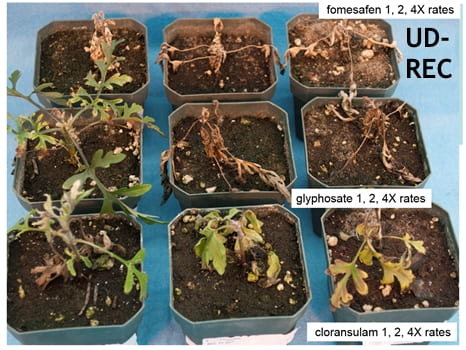Mark VanGessel, Extension Weed Specialist; mjv@udel.edu
UD Weed Science Program received seed from common ragweed plants in the fall of 2015. The seeds came from one field on the Eastern Shore of Maryland, a farm in New Jersey, and two different locations in Delaware. All the fields were heavily infested with common ragweed late in the soybean crop, and all appeared to have survived a glyphosate application.
Individual plants were sprayed with glyphosate, Reflex (fomesafen), and FirstRate (cloransulam) in the greenhouse. Each herbicide was applied at 1X, 2X, and 4X of the normal field use rate. Glyphosate, Reflex and FirstRate are commonly used in soybeans to control common ragweed and they represent three different herbicide sites of action (glyphosate is group 9 (EPSP synthase inhibitors); Reflex is group 14 (PPO inhibitors); and FirstRate is group 2 (ALS inhibitors)).
Plants from MD and NJ survived a 4X application rate of glyphosate, FirstRate (cloransulam), and Reflex (fomesafen). Plants from MD and NJ treated with Reflex did show significant amount of injury, but after 2 weeks the plants began to regrow from meristematic tissue at the leaf axils and quickly recovered. Both fields in DE survived glyphosate and FirstRate, but were successfully controlled with Reflex.
Below are plants from UD-REC (known susceptible) and from MD. Plants were treated with FirstRate (cloransulam, Group 2), glyphosate (Group 9), and Reflex (fomesafen, Group 14). The plants are arranged from bottom row to top in each photo as FirstRate, glyphosate, and Reflex. Rates are 1X, 2X, and 4X of the field rate and arranged from left to right for each herbicide.
Note the plant treated with 1X rate of cloransulam died. This is a result of not all plants carrying the trait for herbicide resistance. This is often observed in the field with dead plants adjacent to living plants of the same species.
The plants below were sprayed with a tankmixture of three herbicide sites of action. Reflex, glyphosate, and FirstRate were mixed in the same spray mix and all at the 2X rate. As observed in the field, some plants were susceptible.
Based on experience with other populations of common ragweed, it is likely that these common ragweed will not be killed with other active ingredients in the same group. So our best advice at this point is to not rely on these herbicide sites of action to control common ragweed in the field. Given that Reflex caused initial injury to common ragweed, it is possible that a crop canopy would suppress the growth and effectively result in not observing these plants late in the season. However, if Reflex was applied early or the soybean canopy was slow to develop or the soybean stand was “thin”, then it is likely that Reflex treated common ragweed plants could recover and complete their life cycle in the field. However, it is not advisable to rely on this strategy.
Because common ragweed typically emerges early in the spring, it is likely that seedlings will be present at the time of applying burndown herbicides in no-till soybeans. Thus an effective herbicide (2,4-D or paraquat) will be needed as part of the burndown tankmixture. Common ragweed is a species that will generally not emerge after the postemergence herbicides are applied. It is a relatively large seeded species and as such the emergence is reduced under no-till conditions compared to conventional tillage.
Current options are limited to only three herbicide sites of action, with Group 5 (atrazine and metribuzin) being the only effective soil-applied herbicides. Cover crops, cultivation or other non-chemical strategies must be included to reduce the density and growth of common ragweed, allowing for higher levels of chemical weed control and ensuring the long-term utility of the few remaining herbicide options.
The populations from Delaware are at risk of developing resistance to Group 14 herbicides as well (Reflex, Cobra, Ultra Blazer, Aim, or Cadet). Currently, Group 14 herbicides labeled for preemergence application (flumioxazin [Valor], saflufenacil [Sharpen], and sulfentrazone [Authority]) are not very effective for common ragweed control. If Group 14 herbicides are used as postemergence herbicides, fields should be scouted within 7 days of applications for surviving plants, and they should be removed to prevent seed production.



